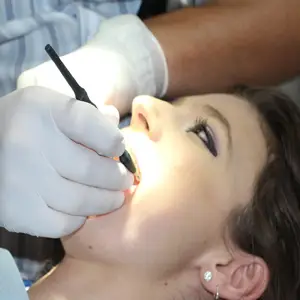What Happens During a Routine Dental Cleaning
Going to the dentist can be daunting-even scary-especially if you haven't been for a long time. But a routine dental cleaning is nothing to be afraid of. It's easy, relatively painless, and will ensure your teeth will have a long life.
A typical cleaning takes between 30 minutes and an hour. During this time you'll be lying down on the dentist chair, usually with your mouth open wide and a light shining into your mouth. Some dentists' offices have tried to ease the anxiety of cleaning by putting TVs on the ceiling so you can watch your favorite movies and shows during the cleaning. It's really a very non-invasive, simple experience and you'll grow to enjoy the clean feeling you get when it's all over.
Here's how a teeth cleaning will usually go:
The Teeth Cleaning
First you'll lie down on the dentist chair. The hygienist will lay a paper cloth across your chest to keep your clothes dry. A light is positioned, and you're all set to begin.
Teeth and Gum Exam
Before the cleaning begins, the hygienist (this will usually be done by the hygienist and not the dentist) will start a physical exam of your entire mouth. This doesn't take long; they use a small mirror to check the teeth and gums to see if you have any glaring problems or if you have any gingivitis they need to be mindful of during the cleaning. If they do see something major, they'll call in the dentist to take a good look at the problem before moving forward.
Scaling
Scaling is what it's called when the hygenist removes plaque and tartar around the gum line and between your teeth. This is done with a little hook called a scaler. You may hear scraping sounds as the scaler brushes away the built-up plaque and tartar on the teeth. If the build up is particularly large, they may use an ultrasonic scaler, which uses gentle vibration to loosen large deposits.
Polishing and Flossing
After the plaque and tartar are cleaned off, the hygienist moves on to polishing and flossing. This is essentially a really intensive tooth-brushing session, though you’re likely to find it more soothing than that. The polishing is done with a little rotating brush called a rubber prophy cup, and they use a paste called prophylaxis paste. This step generally feels just like gentle rubbing. You'll hear the whirring of the rotating brush, but don't worry! There's no drill! This is all just brushing. This step is followed up with the hygienist flossing the teeth thoroughly.
Rinsing
After the brush, the hygienist will have you rinse, often with a little liquid fluoride in the water.
Fluoride Treatment
The last step is the fluoride treatment. This is designed to help protect you from cavities. Typically, with a fluoride treatment the hygenist puts a fluoride gel on a piece of sponge and you bite down onto it and hold your mouth closed tight for a few minutes. You usually have your choice of flavor for gels. This fluoride acts almost like a varnish, which leaves a hard coating on the teeth.
Other Treatments and Education
During the cleaning, there can be many other things that happen. There may be an occlusion check (which checks whether your bite is changing-overbite or underbite). There can be an oral cancer screening. There can be antibiotic therapy if there's an infection. And there can be denture care for those who have them.
Finally, the hygienist will give you education about what needs to be worked on, and how you can continue to keep the teeth clean after the exam is over.
Whether you need endodontic dentistry, pediatric dentistry, cosmetic dentistry or even emergency dentistry, give us a call!
Healthy smiles start here in Cary.
Request an Appointment






